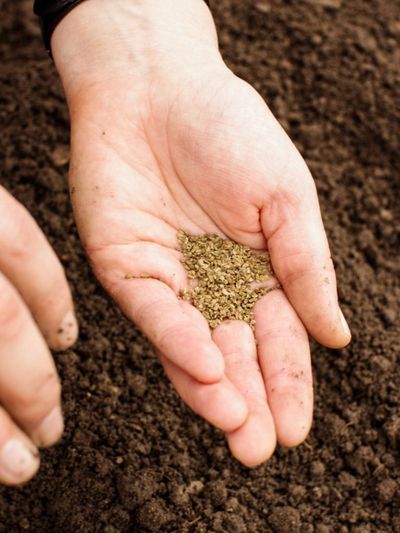By selecting flowers that do well in your region, preparing a seed bed, and planting at the right time in the fall or winter, you can create a beautiful flower border that will reseed itself year after year. Depending on your location, you may also be able to enjoy tasty veggies late in the season too.
Choosing Plants for Fall Sowing
Selecting plants for autumn seed planting will depend on the region where you live. Do some research before starting to find out which annuals, perennials, wildflowers, and grasses perform well in your area. If in doubt, try it out! Some flowers tend to do well in most areas and are suitable for autumn seed planting. Those plants include the following:
Black-Eyed SusanForget Me NotHollyhocksLarkspurColumbinePoppiesPenstemonPurple ConeflowerSnapdragonPerennial SunflowerSweet William
Choose other annuals and perennials by whether they easily self-sow. Also, plants that need cold stratification as indicated on the seed packet are typically good choices for autumn seed planting. Seed packets often say whether the seeds can be planted in fall. There are a number of cold season crops that can be planted during fall as well in suitable climates. These may include:
OnionsGarlicLettuceLeafy GreensBrussel SproutsPeasRadishesChard
After selecting the plants for fall sowing, be sure to buy seeds from a reputable seed catalog or retail center. It may be hard to find seeds in the garden centers in fall, but online sources will be available. If you plan ahead, when spring shopping for seeds, buy your seed packets to plant in the fall as well. Be wary of individuals selling seeds online, you may not get what you expect.
Prepping for Planting Seeds in Fall
Prepare the bed as you would for any planting. Choose a sunny site and remove grass and weeds, if needed. That can be done by solarization in the summer or by spraying with an herbicide. Rake off the dead grass, weeds and rocks. You can loosen the soil a bit with a hand tool or tiller, but it’s best not to disturb the soil too deeply or weed seeds will erupt. Add a layer of compost on top, then you are ready to plant seeds. Some seeds may require light to germinate and others may need darkness. Follow the instructions on the seed packet for sowing. If you are starting a wildflower garden, mix your seeds with sand and broadcast over the planting area. Firm the seeds into the soil by walking over the area.
When to Sow Seeds in Autumn
If you live in an area that experiences cold winters, do not sow the seeds until after a killing frost. You want the seeds to bed down for the winter and sprout in spring. Planting too early in the fall may cause the seeds to start growing, then when cold weather arrives, seedlings will freeze. If you do spot a seedling emerging early, be sure to cover it with mulch. In warm-winter locations, it is best to time the sowing right before the rainy season, usually around late fall or winter. Come spring, seedlings should emerge and, soon thereafter, a colorful array of flowers.
